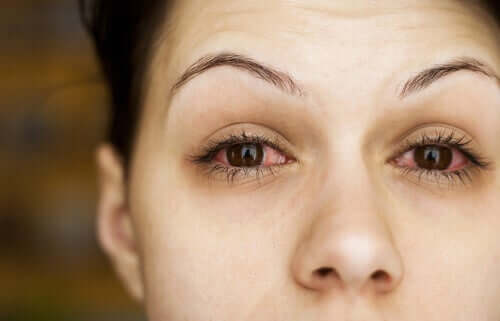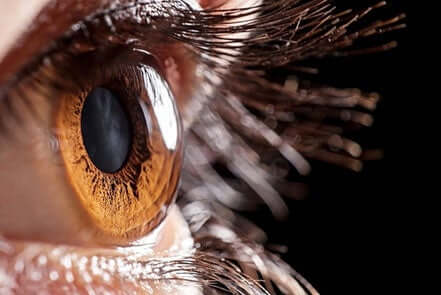Dry Eyes During Menopause


Written and verified by the doctor Leonardo Biolatto
Menopause is a stage in a woman’s life that brings lots of changes throughout the body. Although lots of women hardly experience symptoms, or have mild ones, some suffer severe discomfort. In this article, we’ll look at one of these symptoms: dry eyes during menopause.
Dry eyes is actually a condition that can have lots of causes. It’s when the surface of the eye loses some of the moisture that protects it normally, and it can be very uncomfortable. For example, it can cause itching, visual problems, and even injuries.
Approximately 30% of the population suffers from dry eyes. However, within this percentage, the number of women who suffer it in menopause is very high. Almost 60% of women experience it during menopause.
Therefore, in this article, we’ll explain the relationship between dry eyes and menopause. In addition, we’ll mention a series of steps that can help you improve this problem and reduce discomfort.
What causes dry eyes?
As we mentioned, it’s a pathology that can have different causes. It seems that the relationship with menopause lies in the hormonal changes that happen.
During menopause, estrogen decreases. This decrease in estrogen changes practically all secretions in the body. For example, it also affects the vagina. Therefore, this causes vaginal dryness that’s prominent when having sex.
Unfortunately, dry eyes is the second most frequent symptom in menopause after hot flashes. In addition, it can last up to 4 years. However, it’s not just related to hormones. In fact, aging can also influence it. Some other causes are:
- Wearing contact lenses
- Certain medications, such as antidepressants
- Cancer treatments, such as chemotherapy
- Overuse of heating, or living in a very dry and polluted environment
Dry eyes increase the risk of eye injuries, either to the cornea or elsewhere. In addition, it feels like there’s sand inside, and the eyes feel heavy. Also, it can even affect vision.

You might also like: 5 Remedies to Regulate Hormones Naturally
What are the risks?
Tears from the eyes have a defensive function. They act as a natural cleaning system that carries away particles and germs that can damage the eyes. When this moisture is gone, the eyes get irritated. Therefore, they are more prone to injury.
In addition, the risk of infection goes up. Therefore, if dry eyes aren’t treated, they could end up causing eye damage. In fact, ulcers could even develop.

You might be interested: Diet for Menopause: Nutrients that Shouldn’t Be Left Out
How can you improve dry eyes?
Due to the discomfort and risks of dry eyes, it’s important to treat it. Also, you need to consider certain things. First, we recommend blinking frequently. This helps stimulate the tear ducts.
This is especially important when using lots of electronic devices. Ideally, it’s best to take breaks from your eyes. For example, take breaks while studying, working, or even watching television.
Also, we recommend being careful with the wind and sun. It’s best to always wear sunglasses since they protect particles from entering the eyes. If possible, avoid dry environments.
To do this, you can reduce your use of heating or air conditioning. If you’d prefer not to do this, we’d recommend using humidifiers at home. Also, follow a healthy lifestyle. For example, watch what you eat and drink a lot of water.
In addition, it’s also important to get enough sleep. If you don’t sleep enough, your eyes will suffer and be even more sensitive.
Conclusion
The really important thing is that, if you feel discomfort, you should consult a specialist. Dry eyes can be very annoying and alter your quality of life. However, there are some great therapeutic options to deal with this problem.
All cited sources were thoroughly reviewed by our team to ensure their quality, reliability, currency, and validity. The bibliography of this article was considered reliable and of academic or scientific accuracy.
- Ojo seco: Síntomas y tratamientos | IMO. (n.d.). Retrieved February 24, 2020, from https://www.imo.es/es/ojo-seco
- Ojo seco después de la menopausia | CooperVision Spain. (n.d.). Retrieved February 24, 2020, from https://coopervision.es/blog/ojo-seco-despues-de-la-menopausia
- Lloves, Jesús Merayo. “Conceptos Actuales en Ojo Seco. Del Síndrome a la Enfermedad.” Grupo Español de Superficie Ocular y Cornea (GESOC), Madri: 01-84.
- Menopausia y ojos secos, lo que debes saber – Blog Instituto Oftalmológico Fernández Vega. (n.d.). Retrieved February 24, 2020, from https://fernandez-vega.com/blog/como-influye-la-menopausia-en-la-salud-ocular-de-las-mujeres/
This text is provided for informational purposes only and does not replace consultation with a professional. If in doubt, consult your specialist.








